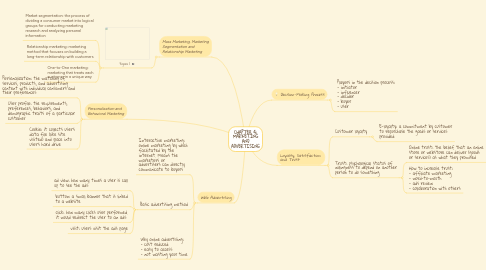
1. Mass Marketing, Marketing Segmentation and Relationship Marketing
1.1. Figure 1
1.1.1. Market segmentation: the process of dividing a consumer market into logical groups for conducting marketing research and analyzing personal information
1.1.2. Relationship marketing: marketing method that focuses on building a long-term relationship with customers
1.1.3. One-to-One marketing: marketing that treats each customer in a unique way
2. Personalization and Behavioral Marketing
2.1. Personalization: the matching of services, products, and advertising content with individual consumers and their preferences
2.2. User profile: the requirements, preferences, behaviors, and demographic traits of a particular customer
2.3. Cookie: it collects user's data file (like site visited) and place into user's hard drive
3. Web Advertising
3.1. Interactive marketing: online marketing by which facilitated by the internet. Means the marketers or advertisers can directly communicate to buyers
3.2. Basic advertising method
3.2.1. ad view: how many times a user is call up to see the ads
3.2.2. button: a small banner that is linked to a website
3.2.3. click: how many clicks user performed. it would redirect the user to an ads
3.2.4. visit: users visit the ads page
3.3. Why online advertising: - cost reduced - easy to access - not wasting your time
4. Decision-Making Process
4.1. Players in the decision process: - initiator - influencer - decider - buyer - user
5. Loyalty, Satisfaction and Trust
5.1. Customer loyalty
5.1.1. E-loyalty: a commitment by customer to repurchase the goods or services provided
5.2. Trust: psychological status of willingness to depend on another person to do something
5.2.1. Online trust: the belief that an online store or webstore can deliver (goods or services) as what they promised
5.2.2. How to increase trust: - affiliate marketing - word-to-mouth - ads review - collaboration with others
